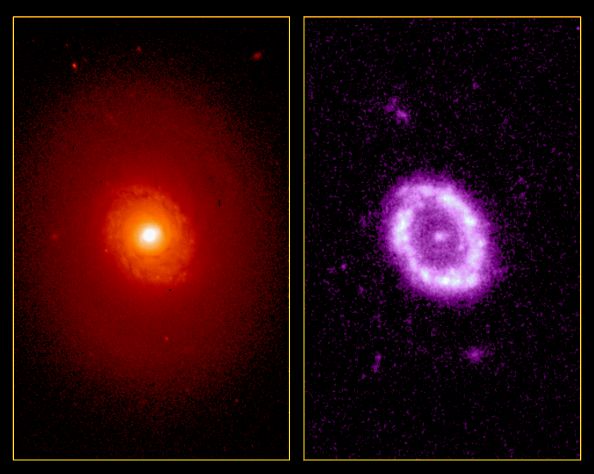Explanation: Today's galaxy, M94 (NGC 4736), lies 15 million light-years away in the constellation Canes Venatici. In the red light image (left), its very bright nucleus and tightly wound spiral arms seem to slowly fade into a faint outer disk. But when viewed in wavelengths shorter than blue light - ultraviolet (UV) light - its appearance dramatically changes. While the red light image highlights the older, cooler stars of M94, the UV picture (right), from the shuttle-borne Ultraviolet Imaging Telescope, is dominated by clusters of massive, hot stars a mere 10 million years young. These UV bright young star clusters are mostly arranged in a stunning ring nearly 7,000 light-years wide around the galactic nucleus. What controls this star forming activity? Exploring wavelengths beyond the blue, astronomers now have evidence that star forming activity in galaxies like M94 can be orchestrated by the symmetric structure of the galaxies themselves instead of the titanic galaxy-galaxy collisions suspected in yesterday's case of the Cartwheel galaxy.
1999 2000 2001 2002 2003 2004 2005 2006 2007 2008 2009 2010 2011 2012 2013 2014 2015 2016 2017 2018 2019 2020 2021 2022 2023 2024 2025 |
Yanvar' Fevral' Mart Aprel' Mai Iyun' Iyul' Avgust Sentyabr' Oktyabr' Noyabr' Dekabr' |
NASA Web Site Statements, Warnings, and Disclaimers
NASA Official: Jay Norris. Specific rights apply.
A service of: LHEA at NASA / GSFC
& Michigan Tech. U.
|
Publikacii s klyuchevymi slovami:
zvezdoobrazovanie - Ul'trafioletovoe izluchenie - NGC 4736 - ultraviolet - star formation - M 94
Publikacii so slovami: zvezdoobrazovanie - Ul'trafioletovoe izluchenie - NGC 4736 - ultraviolet - star formation - M 94 | |
Sm. takzhe:
Vse publikacii na tu zhe temu >> | |
